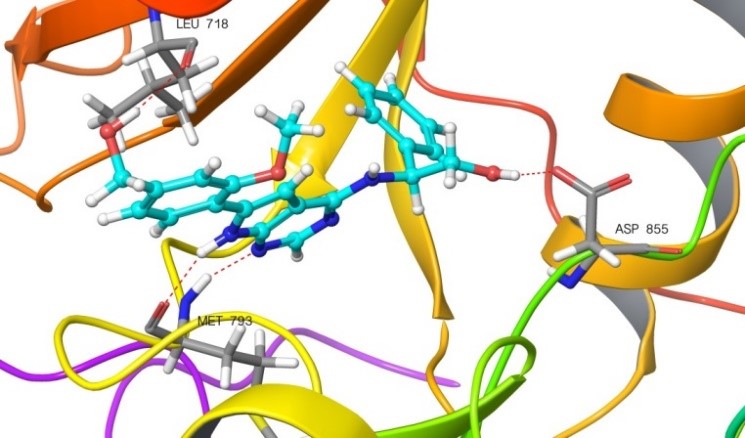Laboratories - Applied Organic Chemistry
Laboratories
Medicinal chemistry
The group takes on medicinal chemistry projects. Past activity includes development of antifungal agents and inhibitors of the epidermal growth factor receptor (EGFR). Current work focus on inhibitors of the colony stimulating factor 1 receptor (CSF1R). Potent and selective inhibitors of this tyrosine kinase could offer treatment for several forms of cancer and inflammation diseases.


At the heart of our activity is the organic chemistry lab. These are well equipped for performing modern organic synthesis. Our aim is to develop scalable divergent routes giving access to a range of products.


Compounds are isolated and purified by conventional methods and characterised using HPLC, NMR and mass spectroscopic methods.


Molecular docking, dynamics and Fragment-growth are used to provide working hypothesis and to explain the binding mode of our new ligands. Druglike properties are monitored by common metrics as Lipinski’s rule of five, LE, LLE, BEI, SEI and LELP. Kinase profiling is performed by CRO’s, while cell and ADME studies are done by both university collaborators and CRO’s.


Organic electronic materials
Dye-sensitized solar cells
A global challenge is that electricity is predominantly generated unsustainably. To improve on the situation, more of the electricity should be generated directly from sunlight by solar cells. Commercial solar cells based on crystalline silicon have increased their efficiencies over the years. However, their widespread global use is hampered by a high production cost. Alternative solar cell technologies are therefore of great interest and one of the most promising candidates is dye-sensitized solar cells (DSSCs), also termed Grätzel cells.


These cells are especially attractive under low-light conditions/in-door applications and as part of building design. The group currently have one project on the synthesis and characterisation of dye-sensitized solar cells. In the DSSC project we focus on phenothiazine based dyes, and aims to increase understanding of the structure-properties relationships. Hopefully, this will aid in the construction of more efficient and stable dyes. The synthesis of such dyes are quite funny as you can follow their colour change as degree of conjugation increase.



At Department of Chemistry (NTNU) we are currently building up a solar cell fabrication and characterisation lab. The dedicated equipment includes:
- Special synthesis
- Microwave, Initiator+ Microwave System w. Robot Eight EU, Biotage
- Centrifuge, Labofuge 300, Heraeus
- Fabrication
- Spin coater, Laurell - WS-650-23B Spin Coater
- Doctor blading, MSK-AFA III, MTI Corporation
- Screen printer, Dyenamo AB
- Programmable furnace, Nabertherm LT 9/11
- Characterisation
- Solar Simulator 300W, Sciencetech SF300B - ABA Class
- Sourcemeter, Keithley 2450
- Monochromator, CM110 Spectral products
- Photoluminescence, Edinburgh Instruments FS5 Sprectrofluorometer
- Potentiostat, Princeton Applied Research – Versastat 3-200
- UV/Vis, U-1900 Spectrophotometer, Hitachi



